

Instructional Design. Gagne's Nine Levels of Learning - Team Management Training From MindTools. Training Your Team Effectively Use this tool to structure and deliver training effectively. © iStockphoto/SchulteProductions Have you ever trained someone on a new process or skill?

Perhaps you thought it would be an easy, straightforward task. But once you actually started the session, it may have been harder than you expected. Everyone has different learning styles . Microsoft Word - MADELINE HUNTER'S LESSON PLAN FORMAT - madeline+hunter's+lesson+plan+format.pdf. Learning Theories of Instructional Design.
Reclaiming Instructional Design - Reclaiming.PDF. Instructional Design. Instructional Design Central. Learning Space. EDUCAUSE Library Items for Learning Space Next Gen Tools: e3 Civic High School Facility April 17, 2014 This innovation brief from Next Generation Learning Challenges (NGLC) focuses on the facility infrastructure of e3 Civic High School--a flexible, open, 21st century space that supports the… Considering Classroom Seating for Students and Faculty in the 21st Century March 19, 2014 In colleges and universities, the physical learning environment embodies an institution’s educational philosophy and priorities.
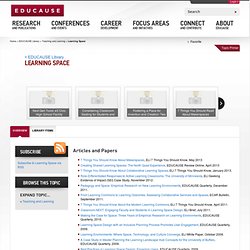
Seven Principles of Good Teaching Practice. Librarians as Instructional Designers: Strategies for Engaging Conversations for Learning. School, academic, and public librarians often cite collaborative partnerships as one of the greatest challenges of the profession—how do we invite collaboration, how do we nurture and sustain those partnerships, and how might those efforts translate into additional endeavors?
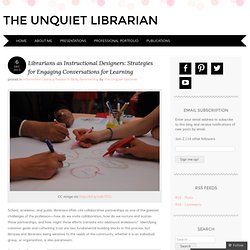
Identifying common goals and cultivating trust are two fundamental building blocks in this process, but libraries and librarians being sensitive to the needs of the community, whether it is an individual, group, or organization, is also paramount. As a school librarian, I have found over the years that my thinking and work as an instructional designer and learning architect are the tasks I dwell in most of the time since they are so critical to the ways that the library can impact the learning culture in very direct and important ways in the larger school environment. As a new librarian here at Norcross High, I’m in the infancy stages of planting and growing trust “seeds” with faculty and students. 1.
Kids Speak Out on Student Engagement. A while back, I was asked, "What engages students? " Sure, I could respond, sharing anecdotes about what I believed to be engaging, but I thought it would be so much better to lob that question to my own eighth graders. The responses I received from all 220 of them seemed to fall under 10 categories, representing reoccuring themes that appeared again and again. So, from the mouths of babes, here are my students' answers to the question: "What engages students? " 1. Working with their peers. Instructional Objectives Builder. Guns in the Classroom - Lisa Rau Cannon. How—and why—I talk to my young students about complex, distressing current events When I asked my middle-school students what an AK-47 is, they flung their arms up so quickly that I thought someone might dislocate a shoulder.
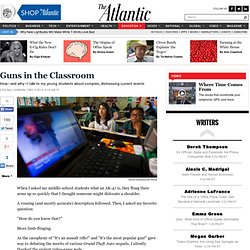
A rousing (and mostly accurate) description followed. Then, I asked my favorite question: "How do you know that? " More limb-flinging. As the cacophony of "It's an assault rifle! " Resources and Downloads for Differentiated Instruction. Tips for downloading: PDF files can be viewed on a wide variety of platforms -- both as a browser plug-in or a stand-alone application -- with Adobe's free Acrobat Reader program.

Click here to download the latest version of Adobe Reader. Click on any title link below to view or download that file. SOCIAL MEDIA FOR HIGHER EDUCATION LEARNING. There’s an ongoing debate about the role social media should play in K-12 education.
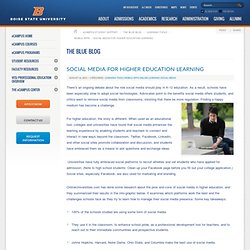
As a result, schools have been especially slow to adopt social technologies. Advocates point to the benefits social media offers students, and critics want to remove social media from classrooms, insisting that there be more regulation. Finding a happy medium has become a challenge. For higher education, the story is different. When used as an educational tool, colleges and universities have found that social media enhances the learning experience by enabling students and teachers to connect and interact in new ways beyond the classroom. Universities have fully embraced social platforms to recruit athletes and vet students who have applied for admission. OnlineUniversities.com has done some research about the pros and cons of social media in higher education, and they summarized their results in the info-graphic below.
Source: Bloom’s Blooming Taxonomy. Remake Your Class: 6 Steps to Get Started. At my design consultancy, TheThirdTeacher+, we believe that, whether it is a large-scale transformation or a small-scale hack, redesigning your classroom is a fun and empowering adventure.

When you involve your students, colleagues and community, you can create a powerful conversation about the role of the environment in the student learning experience. We worked with Edutopia, a collection of creative collaborators and volunteers to help Steve Mattice, a math teacher at Roosevelt Middle School, reimagine his classroom. You can watch the transformation unfold in these videos. Here are the steps that can help you get started today. 1.
Remaking your physical environment is an exciting way to transform your teaching practice and your students' learning experience. 2. Designing a School Makerspace. Makerspaces, STEAM labs and fab labs are popping up in schools across the country.
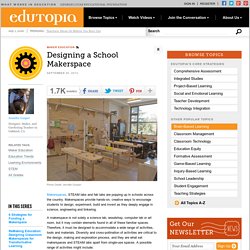
5 Tools to Help Students Learn How to Learn. Helping students learn how to learn: That’s what most educators strive for, and that’s the goal of inquiry learning.
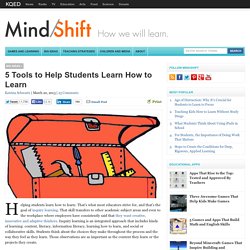
That skill transfers to other academic subject areas and even to the workplace where employers have consistently said that they want creative, innovative and adaptive thinkers. Inquiry learning is an integrated approach that includes kinds of learning: content, literacy, information literacy, learning how to learn, and social or collaborative skills. Students think about the choices they make throughout the process and the way they feel as they learn. Those observations are as important as the content they learn or the projects they create. “We want students thinking about their thinking,” said Leslie Maniotes a teacher effectiveness coach in the Denver Public Schools and one of the authors of Guided Inquiry: Learning in the 21st Century. How long should an e-learning course be? We've all participated in a course, training session, or even conference call that seemed to go on for an eternity.
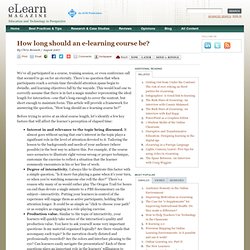
There's no question that when participants reach a certain time threshold attention spans begin to dwindle, and learning objectives fall by the wayside. This would lead one to correctly assume that there is in fact a magic number representing the ideal length for interaction—one that's long enough to cover the content, but short enough to maintain focus. Five Elements of Good Instructional Design. Introduction If you were asked to create a lesson or a training program on a certain topic, where would you start?
As a teacher, you would probably start by thinking about the children who will be learning this lesson. Next, you would have to decide what you want to teach and to what level. This would be your goal and you will have to start constructing your lesson around this goal. If you are a trainer, you start by listing the skills and competencies that your audience should have after receiving your instruction. Irrespective of whom you are creating or designing training material for, you will adopt pretty much the same approach. Chapman Alliance: LMS Selection Services, Learning Technology Consulting, Choosing an LMS - Bryan Chapman Bio. Principles of Online Design. Success For All - Our Instructional Design.
Felder & Soloman: Learning Styles and Strategies. Richard M. Felder Hoechst Celanese Professor of Chemical Engineering North Carolina State University Barbara A. Soloman Coordinator of Advising, First Year College North Carolina State University Active learners tend to retain and understand information best by doing something active with it--discussing or applying it or explaining it to others. Reflective learners prefer to think about it quietly first. Everybody is active sometimes and reflective sometimes. How can active learners help themselves?